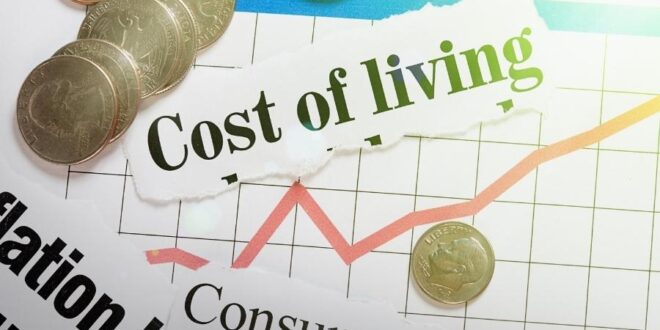Your Cost of Living and Inflation
Inflation was not discussed until quite recently, and for good reason. According to the World Bank, the United States’ total annual rate of inflation in 2019 was 1.8%. (CPI). The rate in 2020 was 1.2%.
However, inflation started to make a comeback in the summer of 2024, with U.S. consumer prices registering their highest annualized gains in more than 13 years.

But in the summer of 2024, inflation started to make a comeback, with the biggest yearly rise in U.S. consumer prices in more than 13 years.
After then, inflation shot up much more. The overall rate of inflation was 4.7% in 2024, and it peaked at 9.1% in June 2024. After then, as a result of the Fed raising interest rates to battle the skyrocketing inflation, the inflation rate started to decline, although it is still quite high.
Even yet, there have been worse inflationary periods. Additionally, the phrases “inflation” and “cost of living hikes” are frequently used, but what do they actually mean? Most importantly, how do they impact your day-to-day activities?
How Bad Is the Housing Crisis?

The decline in “real” disposable incomes (that is, after taxes and benefits, adjusted for inflation) that the US has seen since late 2024 is referred to as the “cost of living crisis.” It has been made worse by recent tax hikes and is mainly driven by rising inflation that is outpacing pay and benefit increases. But you can find the best small loans online to make your situation a little easier.
The administration unveiled several plans to address the crisis’s main flashpoint—the high energy cost—early in February. Rishi Sunak, a former chancellor, revealed a number of more broad initiatives to aid struggling household finances during the spring statement.
Most lower-income people will be largely sheltered from the increase in inflation after taking these policies into consideration. However, for a large number of other households, inflation is still anticipated to rise this year more swiftly than post-tax and benefit wages.
Families with Low and Moderate Incomes Will Be the Worst Harmed

Despite the fact that it appeared as though inflation would be trending downward, recent events have raised the level of uncertainty. Official statistics have not yet captured the impacts of the recent fighting in Europe, and those repercussions are still very much present. Domestically, the government’s recent promises to cut gasoline taxes and public transportation fares in half for three months would temporarily lighten the load on households, especially those in the low- and middle-income categories.
There isn’t much further that monetary or fiscal policy can do to ease these constraints without hurting demand, which hasn’t yet recovered due to concerns surrounding Omicron. After rising by 0.4 percent in October, the Consumer Price Index for All Urban Consumers (CPI-U) increased by just 0.1 percent seasonally adjusted in November.
Unsurprisingly, paying for these basics puts low- to middle-income households in a paycheck-to-paycheck cycle that is difficult to escape, underscoring the need for targeted policy measures to ease the strain on these populations. Any long-term policy initiatives must also ensure an equitable transition and provide incentives for individuals and organizations to lessen their reliance on fossil fuels.
Life Standards and Cost of Living

The degree of wealth, comfort, and requirements that someone may access depending on their socioeconomic standing and location are referred to as their “standard of living.” On the other hand, the term “cost of living” solely refers to the cost of essentials.
Variables that go into determining the level of life:
- Life expectancy
- National economic expansion and the rate of inflation.
- Class discrepancy and the poverty rate.
- Infrastructure.
- Both social and political freedom.
- Environmental conditions and weather.
- Earnings potential and work options.
- Access to high-quality, affordable housing, medical care, and education.
Because of this, the standard of living typically provides a far more complete picture of an individual’s situation than does the cost of living.
Along socio-cultural categories including color, gender, sexual orientation, ability, and age, there are also significant differences in standard of life. It may even help us gauge someone’s subjective happiness or “quality of life.” For the twelve months ending in November, the all-items index rose 7.1%; this was the weakest 12-month gain since the twelve months ending in December 2024.
To understand how we live, the cost of living is still a crucial consideration. If someone’s cost of living increases, it stands to reason that their standard of living and quality of life may also be affected.
Therefore, basic expenses are an important factor to consider while trying to save money and maintain a high level of life.
How to Reduce Your Living Expenses

You have choices if you’ve decided that your cost of living is too high. Moving to a location where your money goes further is one of the most efficient methods to cut your cost of living. You can think about relocating further outside the city or even out of the state if you reside in a high-cost metro region.
Moving isn’t always simple or convenient for everyone, of course. You may also cut your living expenses by:
- Establish and follow a budget: Note the amount of money you have coming in as well as all the expenses you have. Perhaps you can reduce unnecessary expenditure on things like eating out or purchasing online.
- Examine your invoices: Some costs, like phone and insurance, are negotiable. To check whether you may decrease your expenses, speak with your service provider or lender.
- Stop taking out loans: if you carry debt on your credit card each month, you’ll be paying double-digit interest rates. Pay your debt in full each month by the due date to avoid interest.
Conclusion
Cost of living and inflation are related indicators, but they are not the same. The cost of living examines the price of a certain quality of living, which might vary by region, as opposed to measuring the average increase in prices of a basket of items, which is what inflation monitors. Increases in inflation do raise the total cost of living, and the purchasing power of the dollar will fall if wages do not rise in tandem with these increases in the prices of goods and services.
 Imagup General Magazine 2024
Imagup General Magazine 2024



